Starlink offers new services aimed at RV and marine use

It’s been a busy couple of months for Starlink since they rolled out portability. Here’s a quick rundown of what’s happened with the service since then: they’ve rolled out RV service, Dish network has filed a complaint against them, their mobile license was approved by the FCC, and they’ve introduced a maritime service offering. If you’re a boater looking to get internet connectivity on board your boat, that can be a lot to wade through. So, let me help you understand the developments and what it means for us as boaters.
Like all of Elon Musk’s companies, SpaceX and Starlink are a challenge to cover because they have no media relations function. I find all the information about Starlink the same as everyone else. I’m reporting the current state of affairs to the best of my knowledge, but if you have updates or corrections, please share them.
Current services
Starlink currently offers four service types. The table below breaks down the basics of each service.
| Service | Equipment Cost | Monthly Cost | Speeds (mbps) | Notes |
| Residential | $599 | $110 | 50-200 | portability is $25 / month |
| Business | $2,500 | $500 | 100-350 | larger terminal |
| RV | $599 | $135 | 50-200 / 5-100 in congested areas | same terminal as residential, can be activated or suspended month to month |
| Maritime | $10,000 | $5,000 | 100-350 | larger, marinized? two terminals |
Residential
Residential is where it all began. As recently as January of this year, residential service was the only service Starlink offered. Residential service is tied to a specific address. Without the $25 per month portability option, you can only use your service within a small radius of your service address. Additionally, if the cell — Starlink terminology for your area — is at capacity, you will be waitlisted for service. Portability allows you to use the service outside of your service address, but anytime you’re away from your service address your traffic is lower priority than users in their home service.
Business
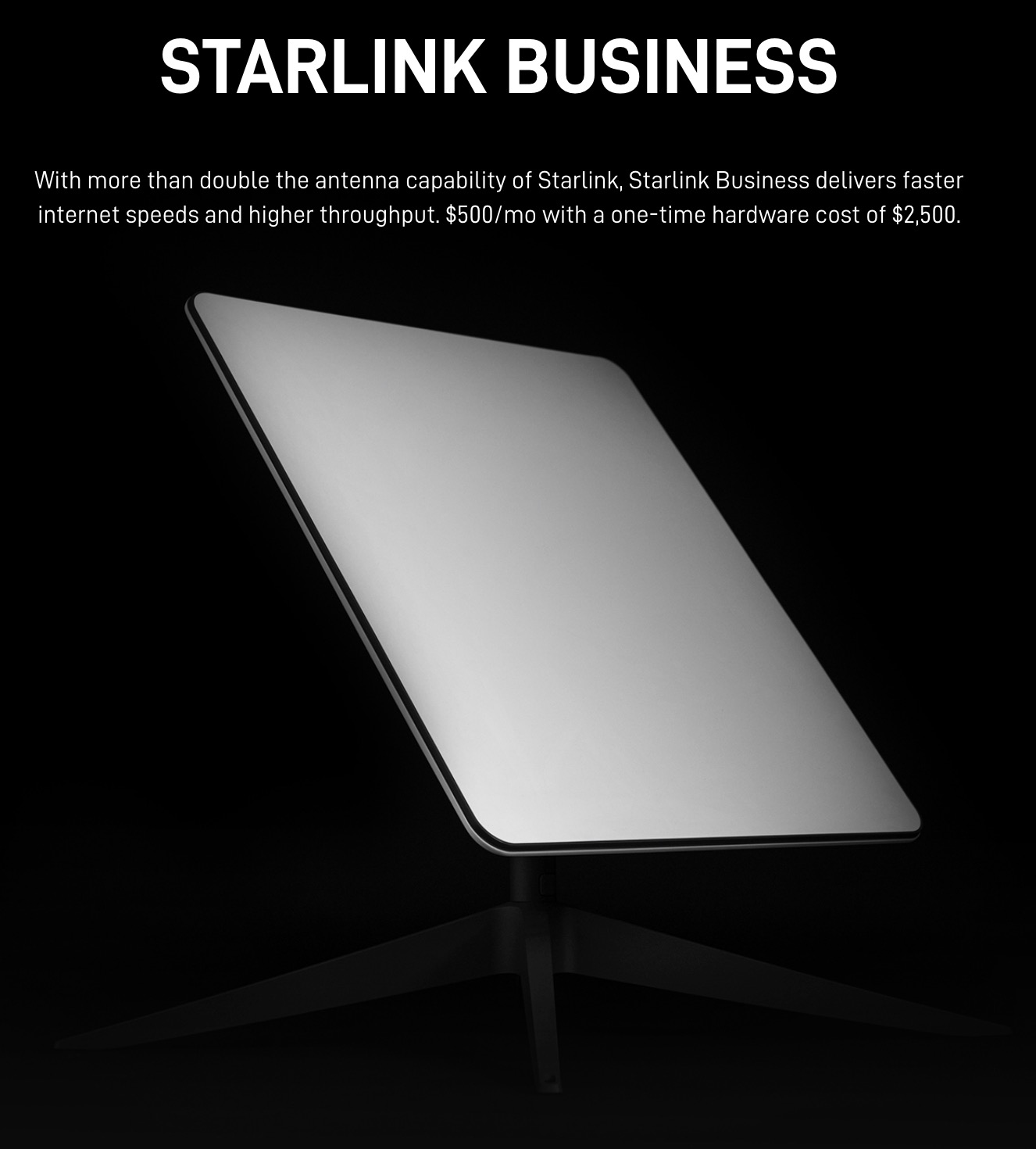
Business is a higher speed plan utilizing a larger terminal, or as Starlink calls them, dishy. Business service is subject to availability in a cell. I put in an address I knew to be full and was invited to reserve my service with a $500 deposit. From what I understand, the business dishy is basically two satellite transceivers in a single enclosure. I haven’t been able to find any mention of portability with business service.
RV
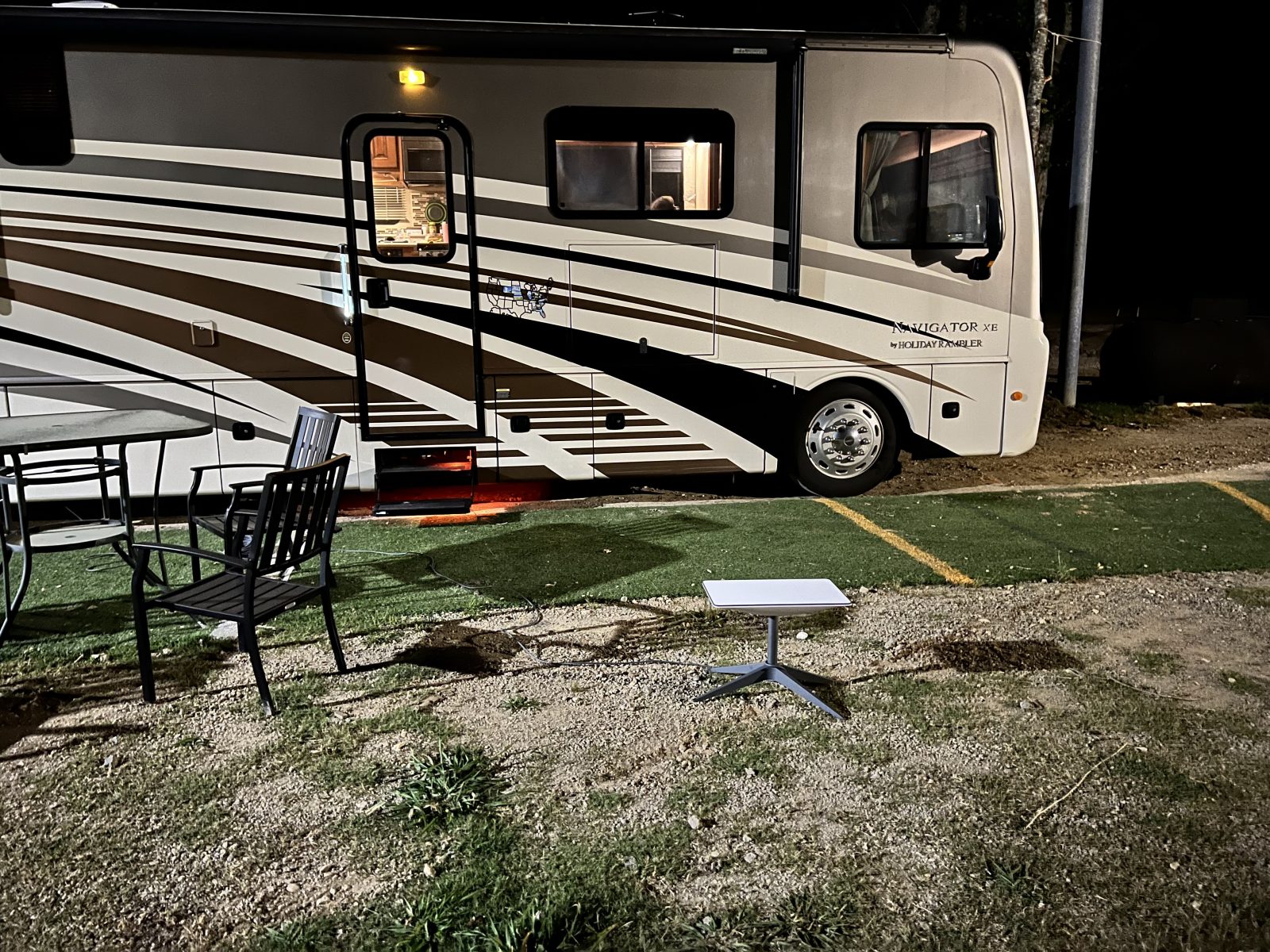
RV builds on residential with a few twists. First, RV service has no service address, so there’s no question of availability. Hence, all RV orders ship immediately. RV service is always lower priority than users within their service area. RV plans can be suspended any time. But, Starlink manages all of their billing by complete month. So, if you have the service active for any portion of a month, you will pay for the whole month. RV apparently uses the same dishy as residential.

When Starlink introduced RV service, they didn’t yet have mobile authorization from the FCC. So, they advertised the service as portable, meaning you could take it from place to place and set it up, but not mobile, meaning it couldn’t be used in motion. Since then, Starlink has received their mobile license and introduced maritime service. But, they haven’t updated their terms of service to allow in-motion use. In fact, they’re still ALL CAPS adamant that it can’t be used in motion. The last sentence, prohibiting installation on a vehicle or vessel, seems hard to square with their RV and maritime services.
Maritime

Maritime is Starlink’s newest and most expensive service. Just days after the FCC approved Starlink for use in motion, Starlink unveiled Maritime. It appears aimed at commercial vessels and superyachts and it’s priced like it. Maritime uses two terminals that appear similar to business units. Although, in a tweet Elon Musk said the terminals are “ruggedized for relentless salt spray & extreme winds & storms in deep ocean.” Obviously, portability is included in Maritime and, like RV, it can be paused and un-paused in one month increments.
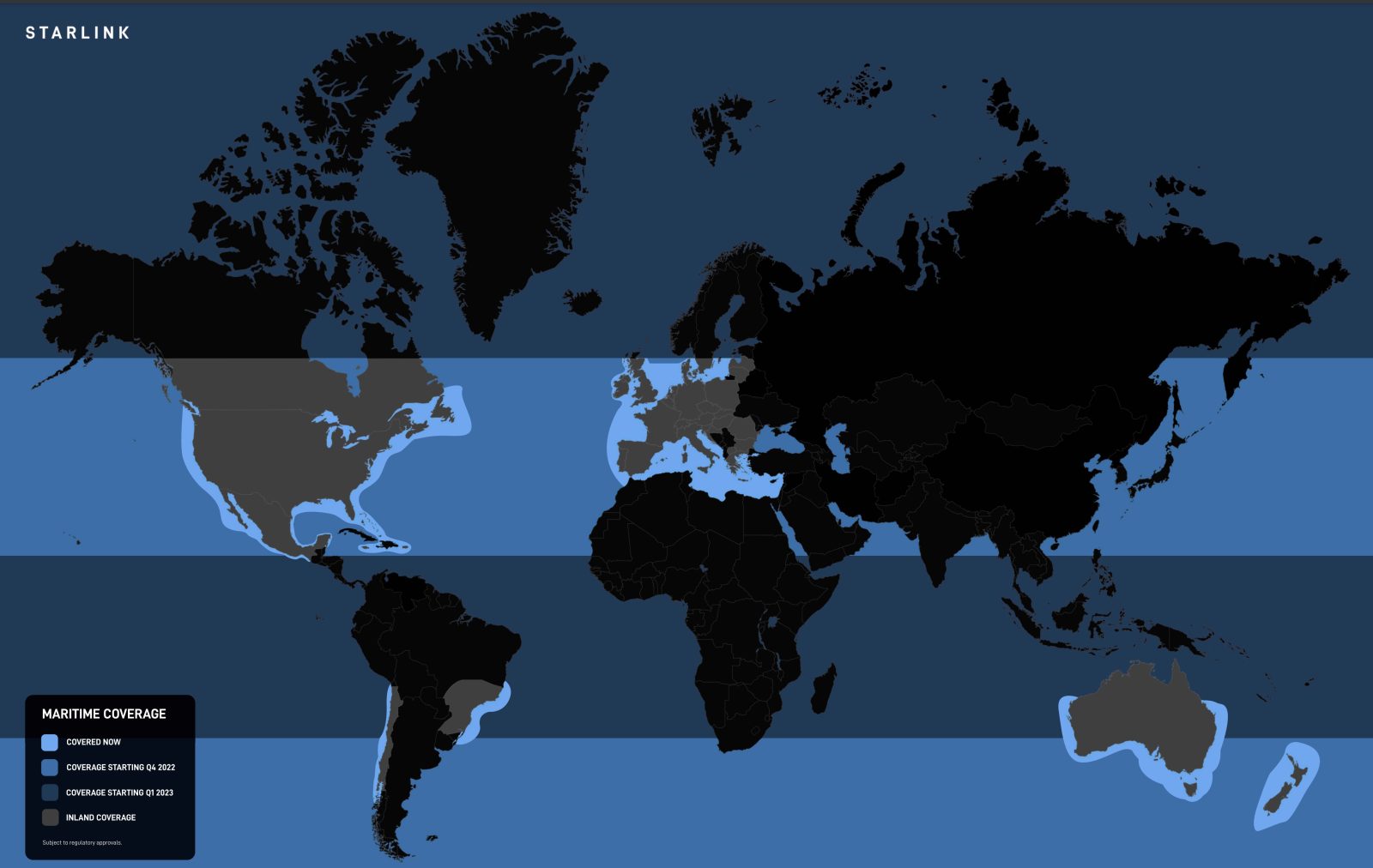
The coverage map above shows that although Starlink is promoting, “connectivity at sea around the globe,” the current coverage is more limited. Current coverage is represented by the lightest blue color seen around coastal areas of the U.S., Europe, Australia, and a little bit of South America. The next darker blue bands are slated for coverage starting in the fourth quarter of 2022, followed by the darkest blue gaining coverage in the first quarter of 2023.
The expanses of ocean that don’t yet have coverage need Starlink’s satellite-to-satellite laser links active to enable coverage. I’ve seen reports indicating Starlink is well into testing those links, but no firm confirmation.

I’ve read a lot of consternation about maritime pricing. Starlink’s promotional material for maritime makes it pretty clear they’re aiming at commercial vessels and megayachts/superyachts. What we don’t know is if Starlink assumes all boaters will use this plan? Will they will come out with a recreational marine plan? Or will the RV plan will continue to work for coastal boaters? I certainly hope Starlink will serve the recreational marine market with a plan and pricing that fits the market. But, as I look at their pricing for global coverage, it doesn’t look bad. Bear with me, I know that $10,000 for equipment and $5,000 a month is a huge leap from $599 and $135, but we really need an apples-to-apples comparison. For offshore coverage, the obvious comparison is to VSAT.
Last year, I wrote about KVH’s new VSAT product line (and they’ve got even newer products just announced) and received some direct feedback about my use of the word affordable. Regardless of what you call it, offshore, global connectivity is expensive. The market is small and the operating costs for the service providers are quite high. The pricing shown above is for KVH’s Elite Unlimited Streaming. KVH’s Elite plan can offer speeds up to 20 megabits per second but in relatively small areas like eastern North America, the Mediterranean, and the Caribbean. That smaller coverage area, slower speed, and higher latency come at a greater per month cost plus dramatically higher equipment costs. The dish capable of 20 Mbps throughput carries a $50,000 list price.
Dish network complaint
In late May, Dish network filed a complaint with the FCC that Starlink wasn’t doing enough to stop subscribers from using their starlink service in motion. They complained particularly that Elon Musk’s tweets promoted using the service in motion at a time when Starlink didn’t possess mobile authorization. It didn’t take the FCC too long to deny Dish’s complaint and approve Starlink’s mobile application. It’s not unusual to see competitors in this space try to use FCC regulations to hold back the competition. I believe that’s the main thing that happened here, but I do think the complaint shows that Dish, and probably others, is worried about Starlink as a competitor.
Recent results
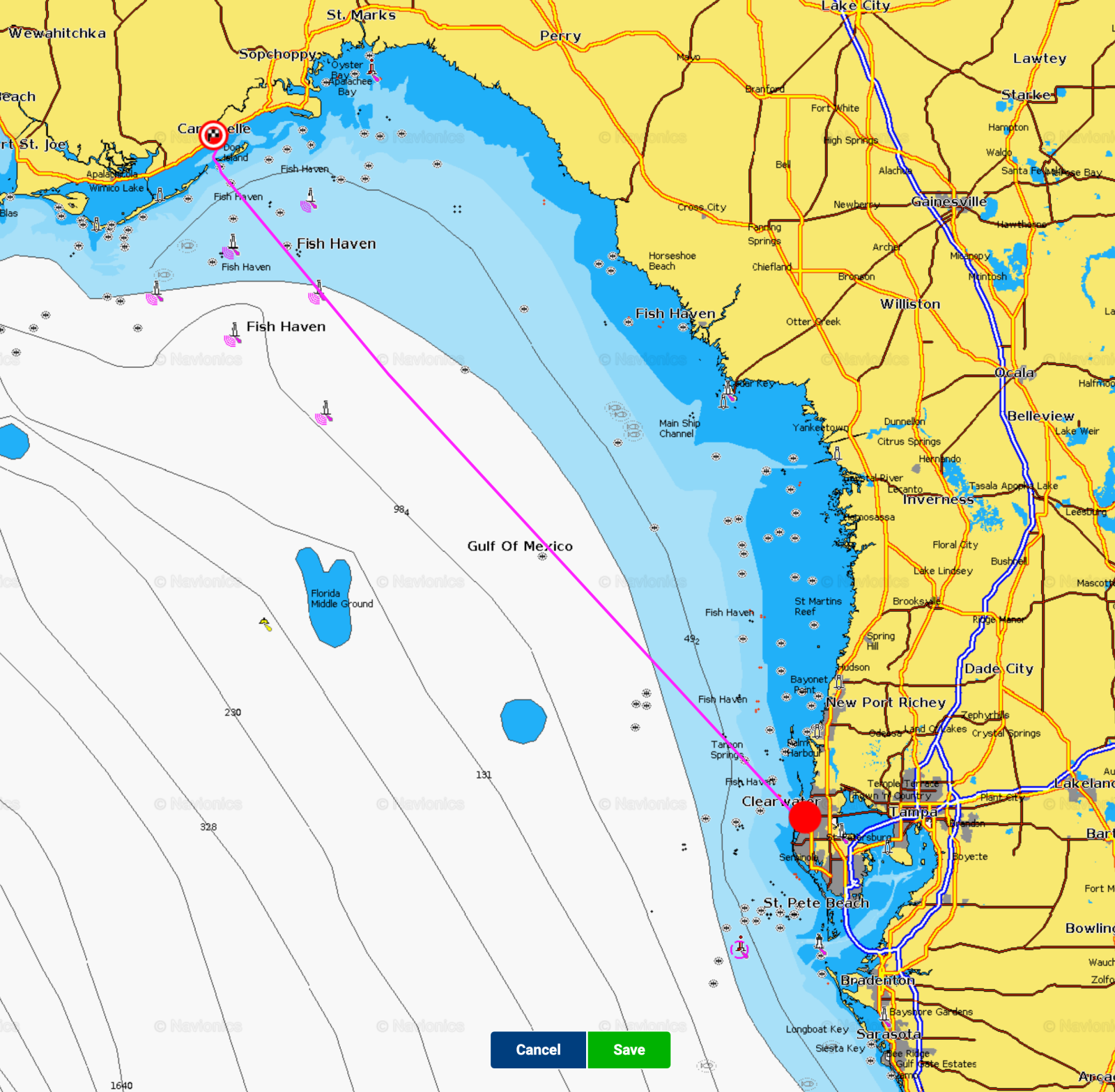
While we wait to see what the future holds, the present is, in my opinion, already a huge improvement over where we were before Starlink. There are regular reports from subscribers to the RV and residential plus portability plans that their service works to about 12 nautical miles offshore. Friends recently crossed the Gulf of Mexico from Clearwater, FL to Carabelle, FL and reported continuous coverage the entire way across the Gulf. They were able to get weather updates, communicate with friends and family via text messaging and WiFi calling, and stream television. That crossing is the longest open water portion of the Great Loop and a source of anxiety for many loopers. Knowing you’re able to communicate with ease can be a significant calming force.
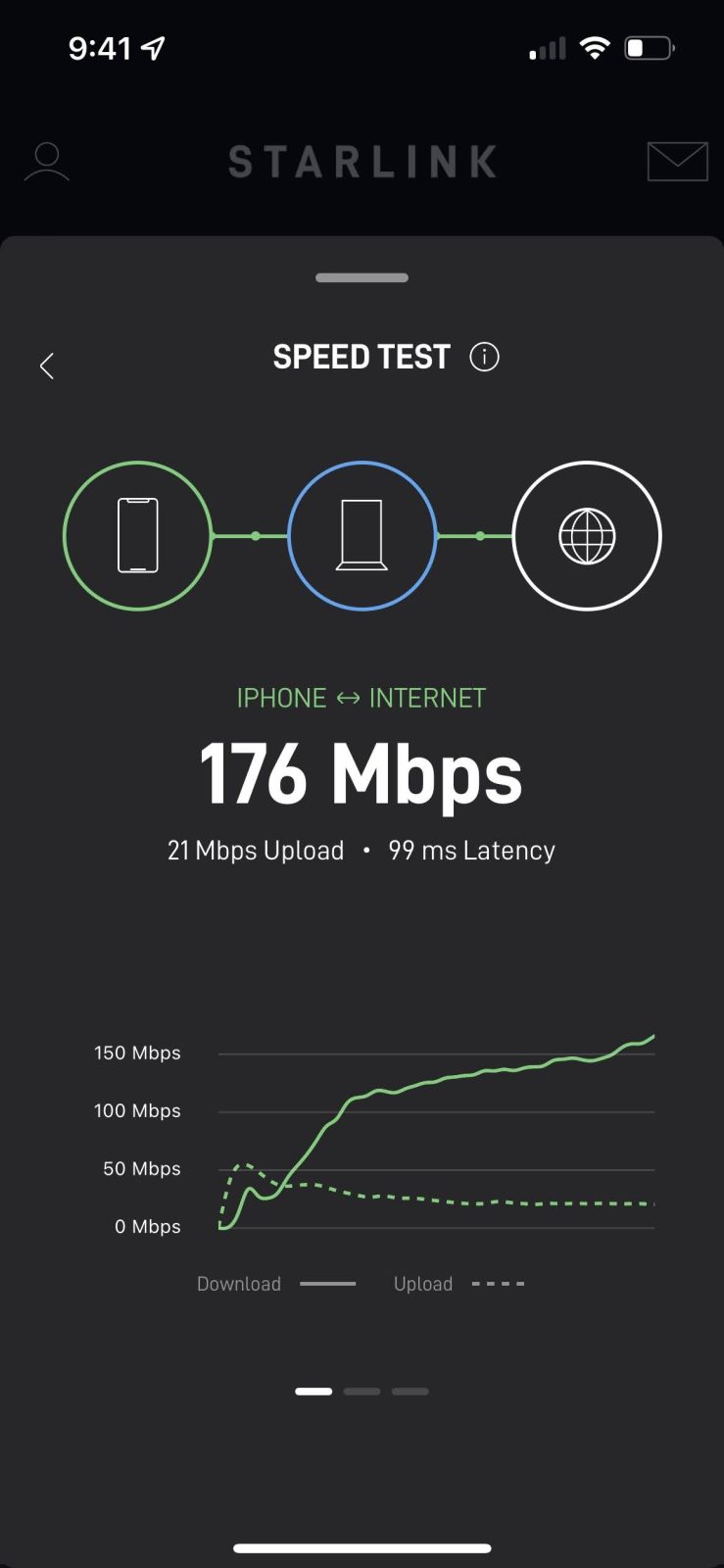
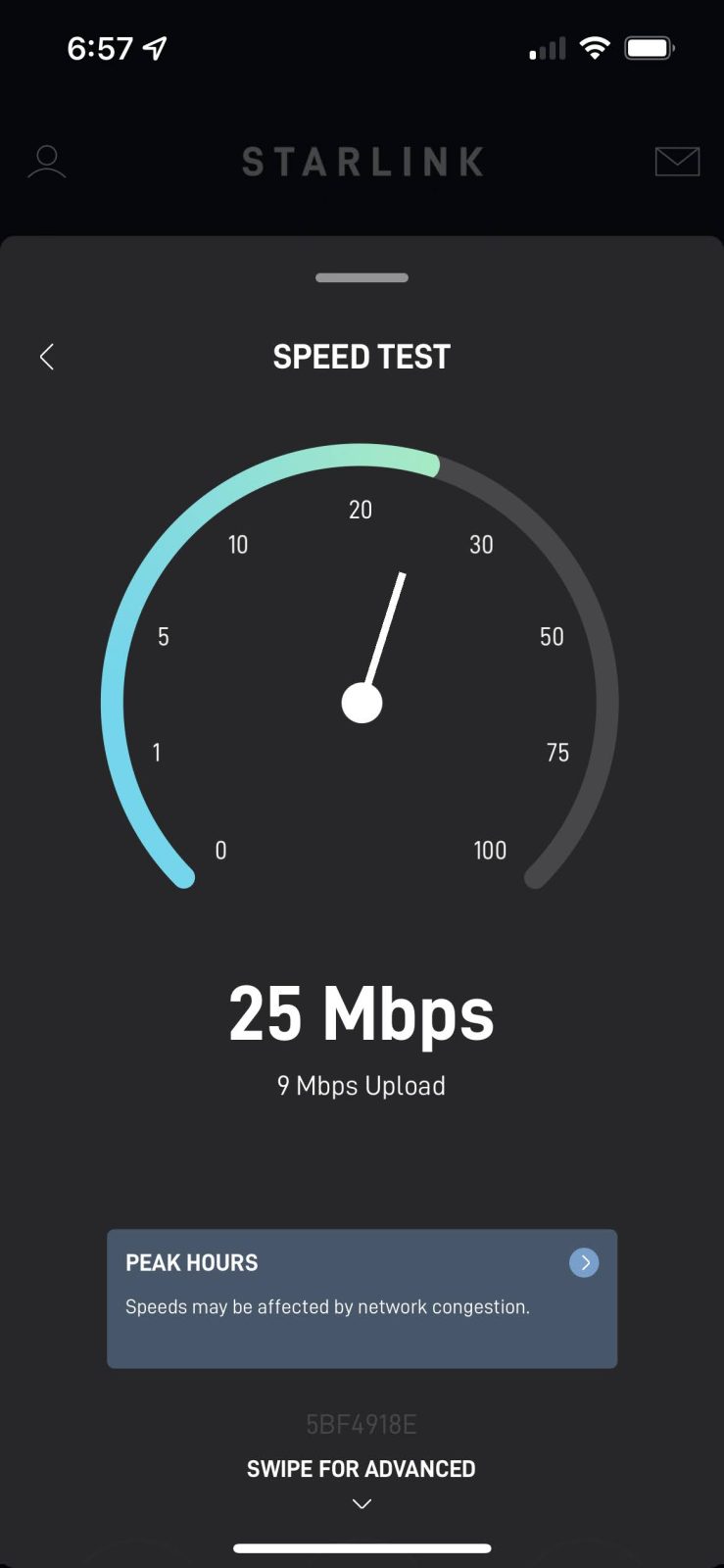
Starlink’s network is very new and expanding every day. They continue to launch mind-boggling numbers of satellites. In the last week, they’ve launched 99 satellites with numerous additional launches scheduled this month. There are currently over 2,500 satellites in orbit. But, they are also adding subscribers to the network very quickly as well. My connection started out very fast when I first activated it in early April. For a period of time I saw my speed test performance dip some, then improve. That cycle has repeated itself a few times. As you can see above, there are times in the evening when I’ll see a performance dip, but overall I continue to see good results.
I’m in southwest Florida in the summer and most afternoons we get storms. If those storms are bad enough to turn a weather radar red, it’s likely we will lose internet connectivity for some period of time. Typically, it’s just a few minutes. I had DirecTV for many years (quite a few years ago) and the outages are similar to what I experienced with them.
Final thoughts
It’s hard to believe how far Starlink has come in such a short period of time. At the beginning of the year when people asked me about Starlnk I told them I thought it would be years before it was viable. It’s now clear I was quite wrong. The future looks good, but there are still some open questions I’m hoping to see filled in about how they will handle recreational boaters. But, in the meantime, status quo is pretty darn good and a major improvement over where we were just six months ago.


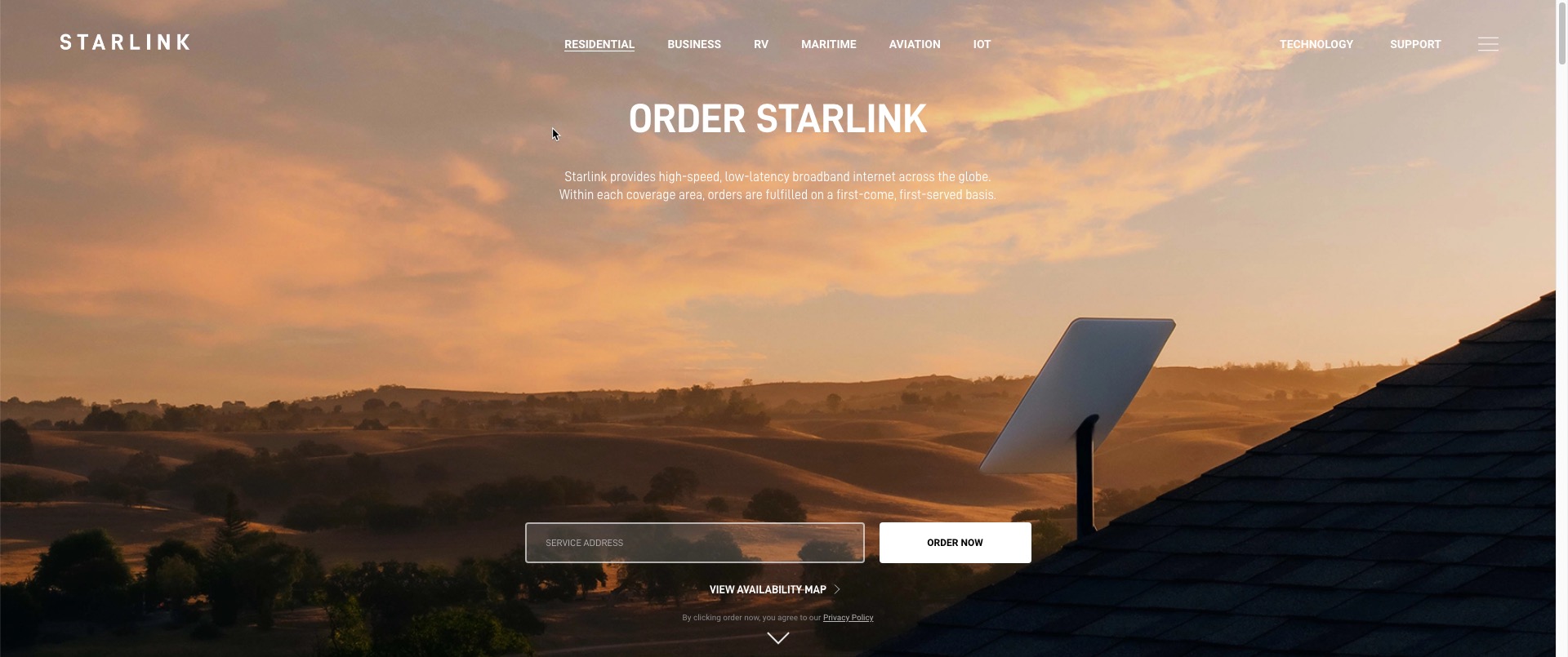






Cudos on clarifying RV/Portability.
I’m liveaboard 40ft sloop.
Notwithstanding, still confusing which to choose.
For the moment I’m on Residential in my marina.
I work aboard so-called digital nomad and need Starlink to work anywhere I’m moored.
Maybe Starlink will figure out if this becomes easier technically/billing and legally more reliable many more boaters would opt in.
Anyway, great article.
Ben, I see some people having to mount dishy on a tall pole I assume in order to clear obstructions, but then I see a couple guys on utube cut the unit down and mount it flat on top their boat and non articulated. Obviously mounted flat is better on a boat so why not?
Roger,
Tall poles are typically to clear obstructions. On RVs they make a lot of sense to give you a fighting chance of getting above potential tree cover. On boats, typically all you need is a tall enough mounting option to clear any super structure or other obstructions from the boat itself.
Indeed, a number of people are making various modifications to their terminals in order to mount them flat on their back and pointing at the sky. I haven’t done this to mine yet, and at least as of now, don’t intend to do so. My thinking on this is two fold: 1) I don’t know enough about the engineering that went into making determinations about where the dish should point to make the decision to circumvent what SpaceX engineers designed. 2) Things are changing so fast with Starlink that I have very little confidence that what makes sense today will make sense tomorrow. As more satellites launch, it’s very possible that ideal aiming will change. Will I regret having disabled my motors? Maybe.
The last factor for me deciding not to modify my dishy is simple. I haven’t had any troubles using it with the motors enabled. The locations I’ve used it work find with it sitting upright. I don’t have it on top of my RV going down the road nor have I tried to use it in motion on the boat much. If I did, that might change my thinking.
-Ben S.
I’m considering it but not having communication with Starlink is MAJOR issue and rarely use any vendor that hides behind a web address without a phone, email or some way of communication. I’d want to use it on the boat and at home so looking for options to make that work. The antenna position on my boat is 73 feet to my office in the home, and would want to include the TVs, another 25 feet. Got a few idea on Trawler Forum, but still a bit confusing.
Larry,
The lack of direct access to the company is part of the package you get with an Elon Musk run company. Personally, I think Starlink has taken it a little far by making it very difficult to access support, but I do get it. In the early 2000s I helped start an online brokerage. Our application process was entirely online and many potential customers had issues with the process. We came to realize that those same customers who had troubles with the online application would also have troubles trading online and perhaps weren’t the best fit for us. I think there’s some of that thought process at work here.
The distances you describe can all be met pretty easily via WiFi. Depending on WiFi congestion in your area you may simply be able to use the Starlink WiFi out of the box, or you may have to use a few WiFi bridges with directional antennas. Experimentation will likely be the best way to get your answer.
-Ben S.
Let’s keep it real… check this out: Debunking Starlink: https://www.youtube.com/watch?v=2vuMzGhc1cg
I haven’t invested the full 43 minutes into this video. But, in the first few minutes, the overwhelming impression is that of a hit piece. He’s criticizing the terminals because they don’t have a removable cord. Okay, but that changed more than six months ago. The rest of the video seems to continue on the same path. Cherry picking the worst possible numbers and facts, even when newer information is available.
Nearly every satellite constellation that’s been launched has seen the company that launched it go through bankruptcy. Only time will tell if Starlink meets the same fate.
-Ben S.
Thanks Ben for your on-going techy-ness. I ‘m wondering, after doing about 30 minutes snooping around on this, if this “mobile” version will run on 12 V power (i.e. in camper/truck off-grid and/or on boat, at anchor, without a generator running and, obviously not being on shore power)??
I can’t find a quick, easy answer…plus i have to realllly concentrate when contemplating these things!
Thanks!
Barb
Hi Barb,
Out of the box, all of Starlink’s hardware requires AC power. There are quite a few people who have figured out how to provide the 48 volts DC the dish actually uses. Most people have done this using a 12v-48v DC-DC converter. I use my Starlink powered by my batteries in both my RV and on the boat, but it’s through inverters in both cases. I think we’re all hoping there’s going to be a recreational marine offering at some point and that it will be 12v powered. Or, even simpler, perhaps Starlink themselves will just offer a 12v power converter.
-Ben S.
Great thanks for that summary. Equally great is my husband says, “Ok, I can do that.” Yay!
Have there been any clues to whether the Maritime hardware kit can be used with the lower speed RV/residential data rate plan ($135/mo) when the $5k a month maritime higher speed data plan is not enabled on it? If so, I would see the logic to plunk down 10k for the marinized HW for recreational use. I have the RV kit installed and have been testing it from Alaska on south on our return to San Fran, and it works great everywhere we’ve been from Petersburg and south from there.
Thus dar, I haven’t seen any indication. But, Starlink’s pattern has been to deal with the high volume, most common cases first and then eventually add the ability to do less common things. We saw that with RV where at first you couldn’t switch from Residential to RV or the other way. Subsequently, they added that capability.
The other big unknown that would change things is whether or not Starlink is losing money on the maritime equipment. If they are, I’d expect that makes it less likely they will permit usage on a lower cost plan. On the other hand, if they’re making money on it (which at $10k is a lot more likely) Starlink might benefit from permitting the usage.
-Ben S.
Hi Ben, I’m a consultant with maritime fisheries and wanted to confirm that costs for vessels at sea (VSAT specifically) include antenna hardware that cost between $35,000 and $150,000 and monthly service between $2,500 and $10,000. At the top end that gets you about 2-4Mbits down/1 Mbit down. So Elon’s headlines are a head-turner for my clients.
However, for business purposes, Starlink will have to answer some questions including SLA (Service Level Agreements), ability to call support, whether they limit data capacity (some of my vessels have up to 140 people on them that all want to do NetFlix), getting a static IP address etc. The current vendors for satellites have large Network Operating Centers (NOC’s) that support their clients. The crews are all seeing this offering and going to their management demanding it – but until Starlink provides some business level answers, it will be tough to abandon the VSAT models that have proven reliability. There are still so many unanswered questions.
Truly this (and OneWeb, etc) are inflection points for the at-sea communication market. The Inmarsats/IntelSats/Iridiums of the world are going to have their worlds turned upside down if Elon actually can deliver a commercially viable product at the pricing they’ve announced.
One final point. The coverage maps don’t show the entire world. I have clients in the Antarctic – and they don’t show this on the map…
starlink isnt going to offer RV style pricing for trans-oceanic customers , why its a tiny market, he’ll sweep up the big comercial boys and fishing fleets etc . for coastal hoppers the RV package will probably suffice most of the time
I’m a consultant with maritime fisheries and wanted to confirm that costs for vessels at sea (VSAT specifically) include antenna hardware that cost between $35,000 and $150,000 and monthly service between $2,500 and $10,000. At the top end that gets you about 2-4Mbits down/1 Mbit down. So Elon’s headlines are a head-turner for my clients.
Loose Cannon has some good info by satcom pro Sean Welsh about whether to disable StarLink motors on boats:
https://loosecannon.substack.com/p/to-point-or-not-to-point-the-starlink